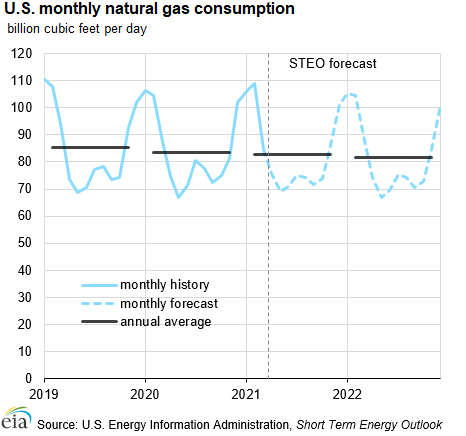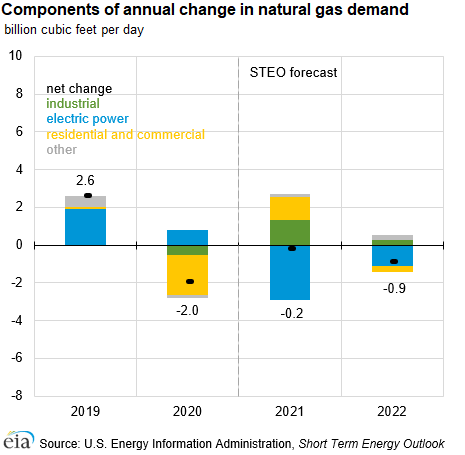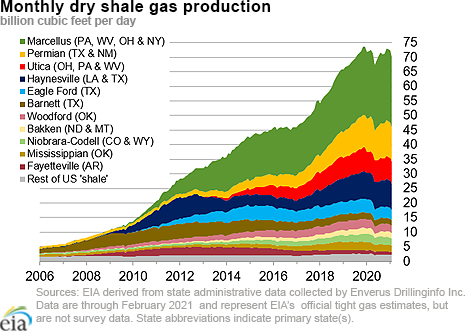In the News:
EIA forecasts that U.S. natural gas consumption will decline through 2022
U.S. natural gas consumption, after having reached an annual average all-time high of 85.2 billion cubic feet per day (Bcf/d) in 2019, declined year over year by 2.0 Bcf/d in 2020. According to our recently released April Short-Term Energy Outlook (STEO), we expect further annual declines, forecasting a decline in natural gas consumption of 0.2 Bcf/day in 2021 and a further decline of 0.9 Bcf/d in 2022. Lower 2020 consumption is attributed to warmer-than-normal weather and a decline in economic activity associated with the COVID-19 pandemic, which results in less natural gas consumption in the industrial sector.
After being the only sector that had growth in natural gas consumption in 2020, we expect the electric power sector to be the only source of natural gas consumption decline in 2021. Natural gas prices in 2019 and 2020 were at historic lows, making natural gas more competitive than coal for generating electric power. However, higher forecast natural gas prices and expectations of increased competition with renewables in 2021 and 2022 have shifted coal and renewables into higher overall shares of electric generation, displacing natural gas in both of these years. We forecast that all other consuming sectors will have increases in demand, but the sum of those increases will not be enough to offset lower consumption in the electric power sector, leading to an overall decrease in 2021.
STEO forecasts use macro-economic assumptions of continued economic growth in 2021 and 2022 produced by IHS Markit, which results in year-over-year forecast increases in industrial sector natural gas consumption during those years. In particular, the natural gas weighted manufacturing index (contained in Table 9a of the April STEO) shows substantial growth in both 2021 and 2022. Colder temperatures during the first quarter of 2021, and expectations for a return to normal weather during the last quarter of 2021 relative to a warmer-than-normal last quarter of 2020, result in higher forecast annual average 2021 consumption in the residential and commercial sectors, followed by a slight decline in 2022.
Overview:
(For the week ending Wednesday, April 7, 2021)
- Natural gas spot prices fell at most locations this report week (Wednesday, March 31 to Wednesday, April 7) as temperatures moderated across the country. The Henry Hub spot price fell from $2.49 per million British thermal units (MMBtu) last Wednesday to $2.38/MMBtu yesterday.
- At the New York Mercantile Exchange (NYMEX), the price of the May 2021 contract decreased 9¢, from $2.608/MMBtu last Wednesday to $2.520/MMBtu yesterday. The price of the 12-month strip averaging May 2021 through April 2022 futures contracts declined 3¢/MMBtu to $2.750/MMBtu.
- The net injections to working gas totaled 20 billion cubic feet (Bcf) for the week ending April 2. Working natural gas stocks totaled 1,784 Bcf, which is 12% lower than the year-ago level and 1% lower than the five-year (2016–2021) average for this week.
- The natural gas plant liquids composite price at Mont Belvieu, Texas, rose by 20¢/MMBtu, averaging $7.61/MMBtu for the week ending April 7. The prices of butane and isobutane followed crude oil prices down, falling by 2% and 1%, respectively. The prices of natural gasoline, ethane, and propane rose by 1%, 1%, and 6%, respectively, reflecting continuing recovery in the petrochemical sector, where they are used as feedstock.
- According to Baker Hughes, for the week ending Tuesday, March 30, the natural gas rig count decreased by 1 to 91. The number of oil-directed rigs rose by 13 to 337. The total rig count increased by 13, and it now stands at 430. Since the start of October 2020, the total rig count has increased 24 out of 27 weeks.
Prices/Supply/Demand:
Prices in most markets fall as moderating temperatures lead to lower demand across most sectors. This report week (Wednesday, March 31 to Wednesday, April 7), the Henry Hub spot price fell 11¢ from $2.49/MMBtu last Wednesday to $2.38/MMBtu yesterday, 2¢/MMBtu above the weekly low of $2.36 set on Tuesday.
Midwest prices fall as temperatures in major consumption centers rise above 65°F at the end of the report week. Temperatures in Chicago reached 70°F and 71°F on Tuesday and Wednesday, respectively, 25°F above normal. At the Chicago Citygate, the price decreased 15¢ from $2.55/MMBtu last Wednesday to $2.40/MMBtu yesterday after reaching a weekly low of $2.23/MMBtu on Monday.
Prices in Northern and Southern California move in opposite directions. After a number of weeks of cooler-than-normal temperatures, weather across California returned to normal- to above-normal temperatures, reducing demand for space heating across the state. The price at PG&E Citygate in Northern California fell 9¢, down from $3.64/MMBtu last Wednesday to a weekly low of $3.55/MMBtu yesterday. Work on the Bethany Compressor Station in the Bay Area continues, but PG&E is no longer reporting capacity constraints on its Redwood Path as it did last week.
The price at SoCal Citygate in Southern California increased 13¢ from $3.00/MMBtu last Wednesday to a weekly high of $3.13/MMBtu yesterday after falling to 2.83/MMBtu on Monday. SoCalGas reports maintenance on the Wheeler Ridge compressor station, which has reduced flows by approximately 400 million cubic feet per day (MMcf/d) starting yesterday. The maintenance is expected to last through April 14, 2021.
Prices in the Northeast also fall as temperatures across the region rose above normal later in the report week. At the Algonquin Citygate, which serves Boston-area consumers, the price fell throughout the report week, declining 62¢ from $2.54/MMBtu last Wednesday to a weekly low of $1.92/MMBtu yesterday. Temperatures in Boston were in the 50’s Monday through Wednesday of this report week, up to 9°F above normal. At the Transcontinental Pipeline Zone 6 trading point for New York City, the price also reached a weekly low yesterday, falling 58¢ from $2.43/MMBtu last Wednesday to $1.85/MMBtu yesterday.
Prices in the Appalachia Basin-producing region fall along with declining demand. IHS Markit reports Northeast supply was 4 Bcf/d above demand for the first time since the third week of October 2020. The Tennessee Zone 4 Marcellus spot price decreased 25¢ from $1.99/MMBtu last Wednesday to $1.74/MMBtu yesterday. The price at Dominion South in southwest Pennsylvania fell 32¢ from $2.12/MMBtu last Wednesday to $1.80/MMBtu yesterday. Both pricing points reported their lowest weekly prices on Monday, at $1.60/MMBtu and $1.73/MMBtu, respectively.
Prices in the Permian production region decrease but by less than the Henry Hub spot price. The price at the Waha Hub in West Texas, which is located near Permian Basin production activities, averaged $2.28/MMBtu last Wednesday, 21¢/MMBtu lower than the Henry Hub price. Yesterday, the price at the Waha Hub averaged $2.24/MMBtu, 4¢/MMBtu lower than last week and 14¢/MMBtu lower than the Henry Hub price.
U.S. production continues to increase. According to data from IHS Markit, the average total supply of natural gas rose by 0.6% compared with the previous report week. Dry natural gas production grew by 0.5% compared with the previous report week to average 92.3 Bcf/d, which is almost the same level as (92.7 Bcf/d) for the same week last year. Average net imports from Canada increased by 4.1% from last week.
Demand for U.S. natural gas fell in all sectors except for deliveries to LNG facilities. Total U.S. consumption of natural gas fell by 2.0% compared with the previous report week, according to data from IHS Markit. Natural gas consumed for power generation declined by 4.0% week over week. Industrial sector consumption decreased slightly by 0.6% week over week. In the residential and commercial sectors, consumption declined by 1.2% as a result of mild temperatures. Natural gas exports to Mexico decreased 8.8% as a result of scheduled seasonal maintenance on pipelines in Mexico. Natural gas deliveries to U.S. liquefied natural gas (LNG) export facilities (LNG pipeline receipts) averaged 11.7 Bcf/d, or 0.09 Bcf/d higher than last week and 30% higher than the same period last year.
U.S. LNG exports decrease week over week. Twenty-one LNG vessels (eight from Sabine Pass, four each from Cameron and Corpus Christi, three from Freeport, and one each from Cove Point and Elba Island) with a combined LNG-carrying capacity of 76 Bcf departed the United States between April 1 and April 7, 2021, according to shipping data provided by Bloomberg Finance, L.P.
Storage:
The net injections into storage totaled 20 Bcf for the week ending April 2, compared with the five-year (2016–2021) average net injections of 8 Bcf and last year's net injections of 30 Bcf during the same week. Working natural gas stocks totaled 1,784 Bcf, which is 24 Bcf lower than the five-year average and 235 Bcf lower than last year at this time.
According to The Desk survey of natural gas analysts, estimates of the weekly net change to working natural gas stocks ranged from net injections of 11 Bcf to 30 Bcf, with a median estimate of 22 Bcf.
More storage data and analysis can be found on the Natural Gas Storage Dashboard and the Weekly Natural Gas Storage Report.
See also:
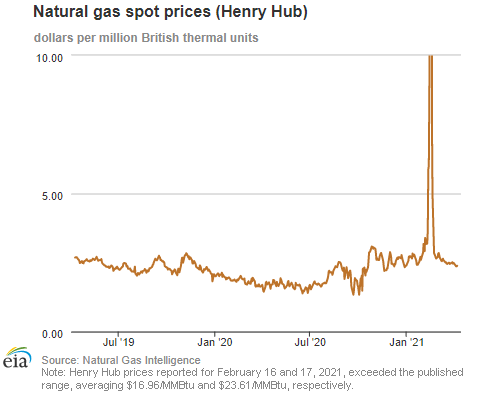
| Spot Prices ($/MMBtu) | Thu, 01-Apr |
Fri, 02-Apr |
Mon, 05-Apr |
Tue, 06-Apr |
Wed, 07-Apr |
|---|---|---|---|---|---|
| Henry Hub | 2.47 | Closed | 2.37 | 2.36 | 2.38 |
| New York | 2.15 | Closed | 1.76 | 1.85 | 1.85 |
| Chicago | 2.40 | Closed | 2.23 | 2.31 | 2.40 |
| Cal. Comp. Avg,* | 2.83 | Closed | 2.76 | 2.77 | 2.86 |
| Futures ($/MMBtu) | |||||
| May Contract | 2.639 | Closed | 2.511 | 2.456 | 2.520 |
| June Contract | 2.697 | Closed | 2.582 | 2.536 | 2.597 |
| *Avg. of NGI's reported prices for: Malin, PG&E Citygate, and Southern California Border Avg. | |||||
| Source: NGI's Daily Gas Price Index | |||||
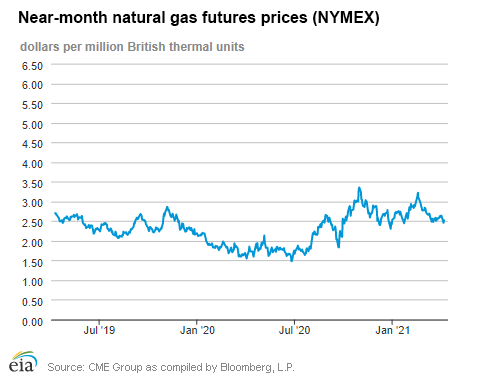
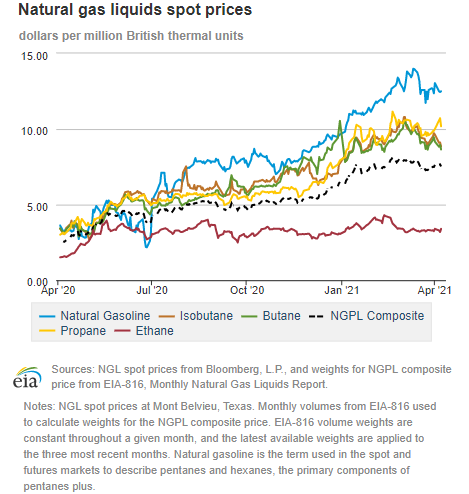
| U.S. natural gas supply - Gas Week: (4/1/21 - 4/7/21) | |||
|---|---|---|---|
Average daily values (Bcf/d): |
|||
this week |
last week |
last year |
|
| Marketed production | 104.0 |
103.6 |
104.4 |
| Dry production | 92.3 |
91.9 |
92.7 |
| Net Canada imports | 4.3 |
4.1 |
3.8 |
| LNG pipeline deliveries | 0.1 |
0.1 |
0.1 |
| Total supply | 96.7 |
96.1 |
96.6 |
|
Source: IHS Markit | |||
| U.S. natural gas consumption - Gas Week: (4/1/21 - 4/7/21) | |||
|---|---|---|---|
Average daily values (Bcf/d): |
|||
this week |
last week |
last year |
|
| U.S. consumption | 67.2 |
68.5 |
70.1 |
| Power | 23.8 |
24.8 |
25.6 |
| Industrial | 22.9 |
23.1 |
22.0 |
| Residential/commercial | 20.4 |
20.7 |
22.5 |
| Mexico exports | 5.5 |
6.1 |
4.9 |
| Pipeline fuel use/losses | 6.3 |
6.3 |
6.5 |
| LNG pipeline receipts | 11.7 |
11.6 |
9.0 |
| Total demand | 90.7 |
92.5 |
90.5 |
|
Source: IHS Markit | |||
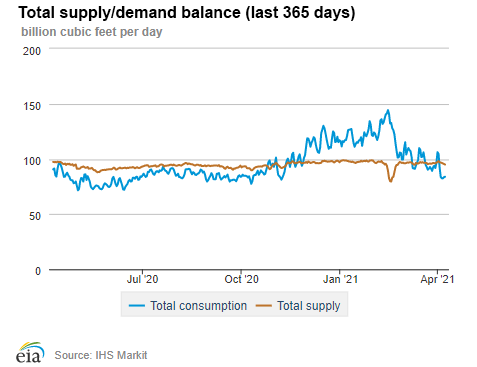
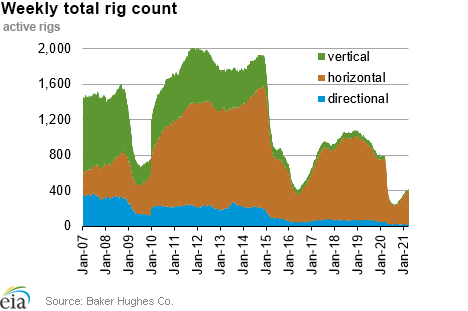
| Rigs | |||
|---|---|---|---|
Tue, March 30, 2021 |
Change from |
||
last week |
last year |
||
| Oil rigs | 337 |
4.0% |
-40.0% |
| Natural gas rigs | 91 |
-1.1% |
-9.0% |
| Note: Excludes any miscellaneous rigs | |||
| Rig numbers by type | |||
|---|---|---|---|
Tue, March 30, 2021 |
Change from |
||
last week |
last year |
||
| Vertical | 20 |
-9.1% |
-33.3% |
| Horizontal | 391 |
2.9% |
-34.1% |
| Directional | 19 |
26.7% |
-53.7% |
| Source: Baker Hughes Co. | |||
| Working gas in underground storage | ||||
|---|---|---|---|---|
Stocks billion cubic feet (Bcf) |
||||
| Region | 2021-04-02 |
2021-03-26 |
change |
|
| East | 305 |
307 |
-2 |
|
| Midwest | 398 |
401 |
-3 |
|
| Mountain | 115 |
112 |
3 |
|
| Pacific | 198 |
194 |
4 |
|
| South Central | 768 |
749 |
19 |
|
| Total | 1,784 |
1,764 |
20 |
|
|
Source: Form EIA-912, Weekly Underground Natural Gas Storage Report | ||||
| Working gas in underground storage | |||||
|---|---|---|---|---|---|
Historical comparisons |
|||||
Year ago (4/2/20) |
5-year average (2016-2020) |
||||
| Region | Stocks (Bcf) |
% change |
Stocks (Bcf) |
% change |
|
| East | 382 |
-20.2 |
303 |
0.7 |
|
| Midwest | 475 |
-16.2 |
400 |
-0.5 |
|
| Mountain | 92 |
25.0 |
106 |
8.5 |
|
| Pacific | 202 |
-2.0 |
194 |
2.1 |
|
| South Central | 867 |
-11.4 |
806 |
-4.7 |
|
| Total | 2,019 |
-11.6 |
1,808 |
-1.3 |
|
| Source: Form EIA-912, Weekly Underground Natural Gas Storage Report | |||||
| Temperature – heating & cooling degree days (week ending Apr 01) | ||||||||
|---|---|---|---|---|---|---|---|---|
HDD deviation from: |
CDD deviation from: |
|||||||
| Region | HDD Current |
normal |
last year |
CDD Current |
normal |
last year |
||
| New England | 115 |
-57 |
-45 |
0 |
0 |
0 |
||
| Middle Atlantic | 103 |
-53 |
-27 |
0 |
0 |
0 |
||
| E N Central | 145 |
-17 |
22 |
0 |
0 |
0 |
||
| W N Central | 153 |
-6 |
36 |
0 |
-1 |
0 |
||
| South Atlantic | 54 |
-31 |
10 |
30 |
17 |
-6 |
||
| E S Central | 68 |
-12 |
37 |
6 |
1 |
-13 |
||
| W S Central | 36 |
-8 |
21 |
18 |
4 |
-24 |
||
| Mountain | 144 |
5 |
-7 |
3 |
-1 |
3 |
||
| Pacific | 58 |
-22 |
-58 |
0 |
-2 |
0 |
||
| United States | 100 |
-22 |
-3 |
8 |
3 |
-4 |
||
|
Note: HDD = heating degree day; CDD = cooling degree day Source: National Oceanic and Atmospheric Administration | ||||||||
Average temperature (°F)
7-day mean ending Apr 01, 2021
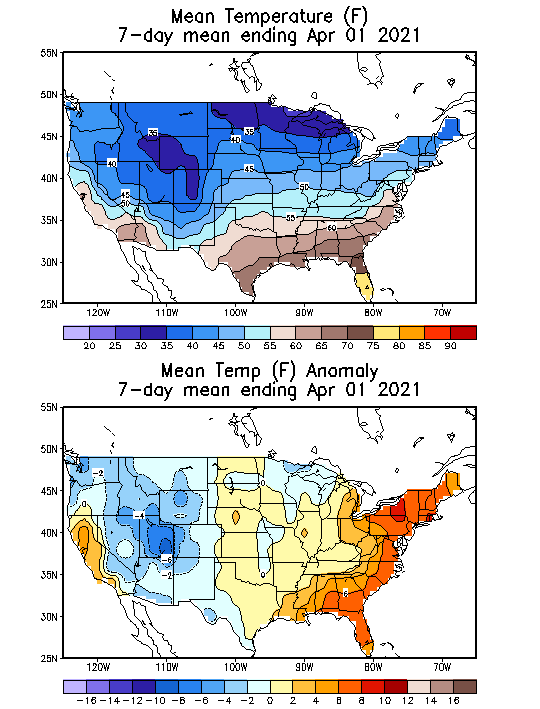
Source: National Oceanic and Atmospheric Administration
Deviation between average and normal (°F)
7-day mean ending Apr 01, 2021

Source: National Oceanic and Atmospheric Administration

